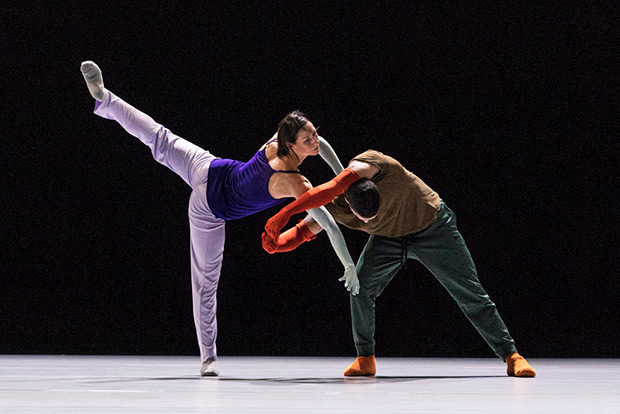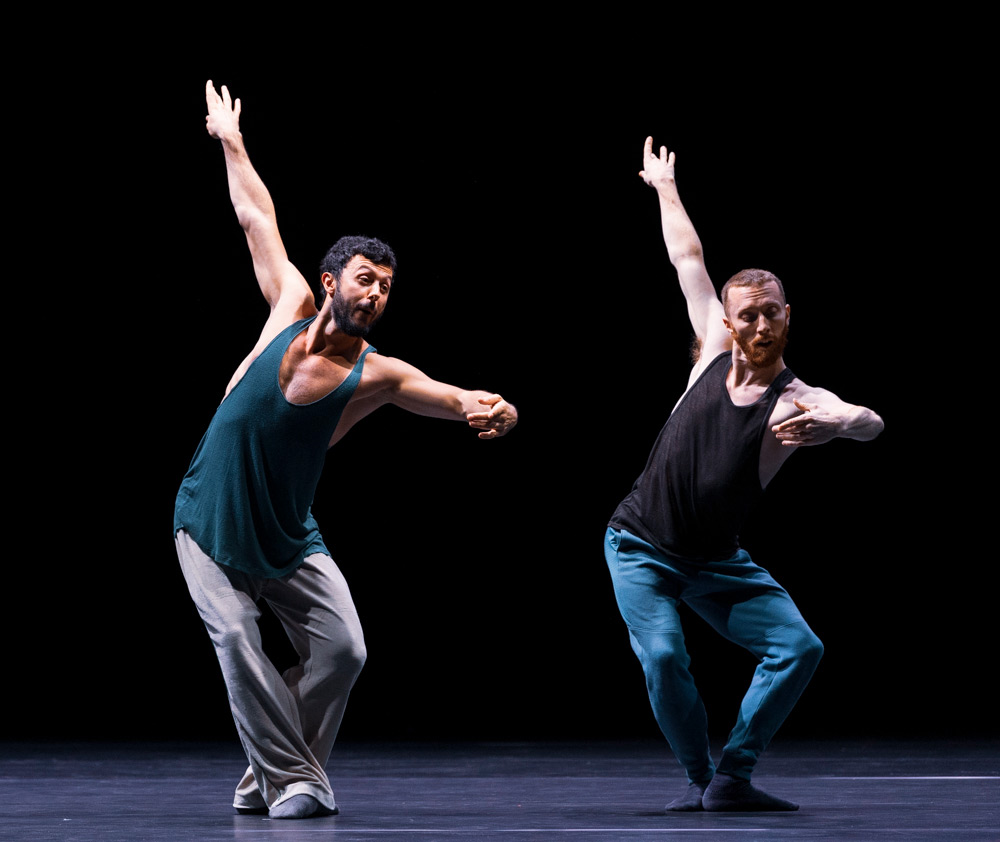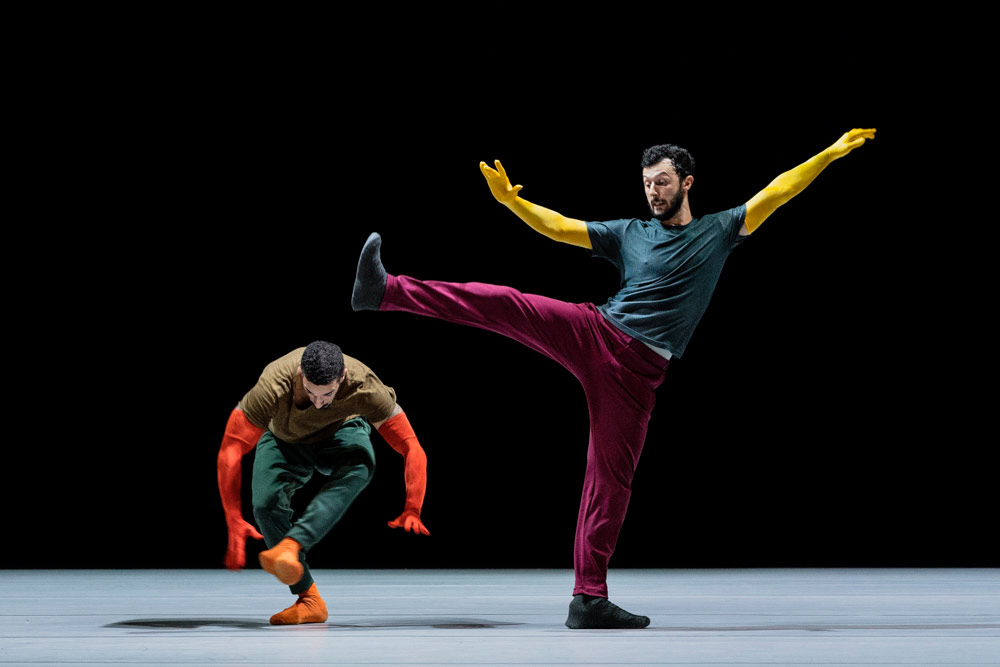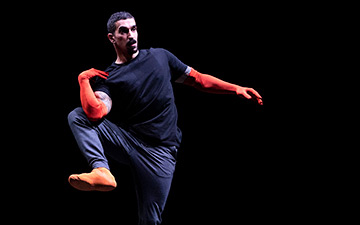
© Foteini Christofilopoulou. (Click image for larger version)
William Forsythe
A Quiet Evening of Dance: Dialogue, Seventeen/Twenty One
★★★✰✰
New York, The Shed
11 October 2019
Gallery of pictures by Foteini Christofilopoulou (2018)
www.williamforsythe.com
theshed.org
In High Style
In William Forsythe’s A Quiet Evening of Dance, in the upstairs Griffin Theater at The Shed through Oct. 25, many of the dancers wear long, silky, gloves in contrasting colors, a splash of vibrancy in the dancers’ otherwise generic dance attire. Their footwear (some seem to be wearing sneakers, others, ballet slippers) is similarly sheathed in colored fabric, either to create a sleeker line or to allow for sliding, I’m not sure. The silky accessories have the effect of drawing the eye to the dancers’ hands and feet. The feet are sharply pointed, held in a very Balanchinean, over-crossed line that creates a torque through the body. The fingers are splayed in an exaggeration of Balanchine’s we-should-see-all-five-fingers pose. The arms, very often held in third position – one up, one to the side – are almost always, allongé, in other words, with the arms straight and hands stretched rather than curved. These amplified poses read like exclamation points, or accents at the end of a phrase.
Which is to say that A Quiet Evening of Dance may be quiet in terms of its musical volume and stage presentation, but certainly not quiet in its ideas about dance and, in particular, ballet. This is ballet! It seems to cry out at every turn. The evening was co-commissioned by Sadler’s Wells, and premiered there last year. It features a cast of ten, many of them longtime collaborators and former members of the Forsythe Company. That company, based in Germany, was led by Forsythe until 2015, when he returned to the US. Since then he has been busily making new works for various ballet companies.

© Foteini Christofilopoulou. (Click image for larger version)
The fascination with ballet is strong in Forsythe. After years of creating a form of dance theater in Germany, he has returned to his classical roots with a renewed energy. With their splayed fingers and exaggerated, hyper-extended arms, the dancers seem to be teasing out the mannerist extremes of the form. The vocabulary takes the modernism of Balanchine’s black and white ballets as a starting point. This tribute is not hidden; the first half of the evening, which is more like a series of études, mostly performed in silence, to a smattering of birdsong and a Morton Feldman piano work, makes direct reference to ballets like The Four Temperaments and Agon. There are various direct quotations one can pick out: arms held out to the side, wrists flexed, one up, one down, while standing with one leg extended behind the body, in the position known in ballet as B+; an x formed with the arms and legs, while balancing on the heels; the intersection of arms as partners approach each other for a pas de deux, creating a grid shape.

© Mohamed Sadek, courtesy The Shed. (Click image for larger version)
In this first section, steps are seen in isolation, in solos and duets. A section for two women (Jill Johnston and Brit Rodemund) begins with a long sequence in which the women pat different parts of their torso, as if measuring its geometry. Then, the arms evolve toward ballets poses. They begin to execute small jumps: glissades, sissonnes. From there, they move on to twisted and torqued poses, magnifications of ballet’s epaulement, the angle between the hips, shoulders, arms, and head. In Dialogue, a duet for two men (Brigel Gjoka and Riley Watts) that follows, the vocabulary is expanded to include more ballet steps: ronds de jambe, attitudes, arabesque penchée, plus a few of Balanchine’s characteristic taps of the toes. More humor and eccentricity seeps in; Gjoka is a wonderfully vivid performer, loose-limbed, facially expressive. In his hands this alphabet soup of steps becomes a marvelous game.

© Foteini Christofilopoulou. (Click image for larger version)
After the intermission, the dancers return, now accompanied by a recording of Jean-Philippe Rameau’s “Hippolyte et Aricie: Ritournelle.” The music is stately and formal, in that French Baroque way, a perfect trampoline for a dance that revels in the baroquisme of ballet: again the splayed fingers, elevated torsos, pointed feet. This piece is called Seventeen/Twenty One, a reference to the 17th and 21st centuries. It’s a highly-evolved study of style, which the dancers execute with verve, adding supercilious, delighted or ironic facial expressions. I found myself tiring of it quickly, with the exception of two sections, both of which featured the dancer Rauf “Rubber Legz” Yasit. Yasit’s training is different from that of the others; there’s a bit of hip-hop footwork, floorwork, and tumbling, and who knows what else. He’s an extraordinary mover, and a bit of a contortionist able to reconfigure his body into any shape, any coordination. In a duet with Roderick George, the two men are like pieces in a puzzle, interlocking, folding, wrapping around each other: shoulder to thigh, cheek to knee, arm wrapped around a leg. For a moment the high stylistic gloss melts away, and the movement acquires depth, inspiring a sense of curiosity. Who are these two men? What goes on between them?

© Foteini Christofilopoulou. (Click image for larger version)
The other duet involves Yasit and Parvaneh Scharafali. Two styles of movement collide – mannerist and angular vs. grounded and fluid. Yasit partners Scharafali in arabesques, their arms intertwine. Often it is she who initiates or leads a partnering move. The story is the oldest one in the book: opposites attract. Nevertheless, Yasit, like the jester-like Brigel Gjoka in the first half of the evening, projects a warmth and directness that engages something beyond the intellect. For a moment, the dancing loses its sheen of knowingness and commentary and becomes just that: dancing.

















You must be logged in to post a comment.